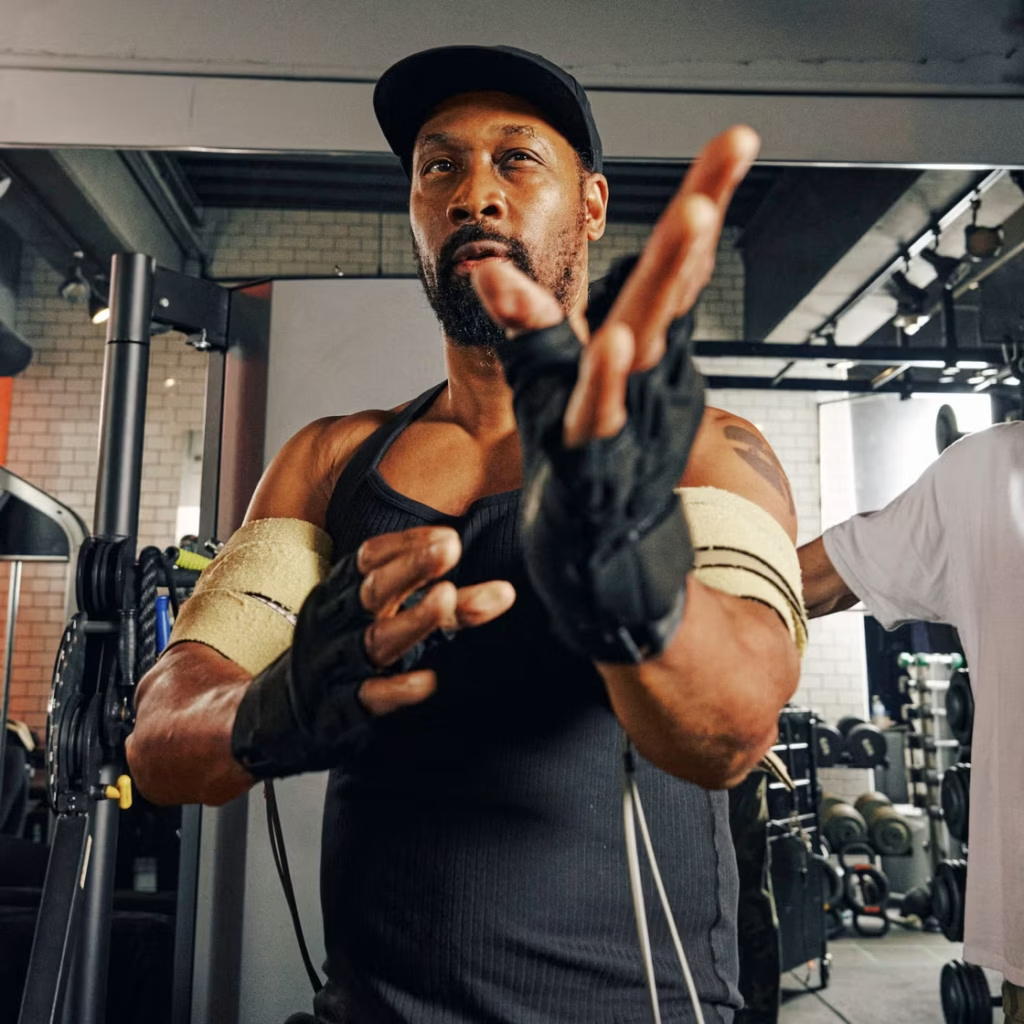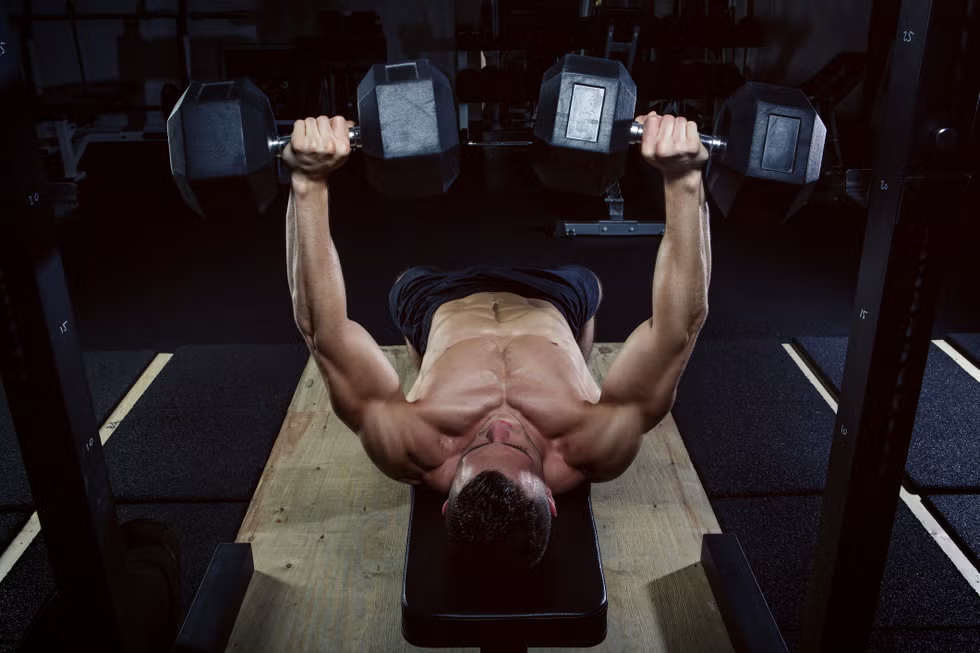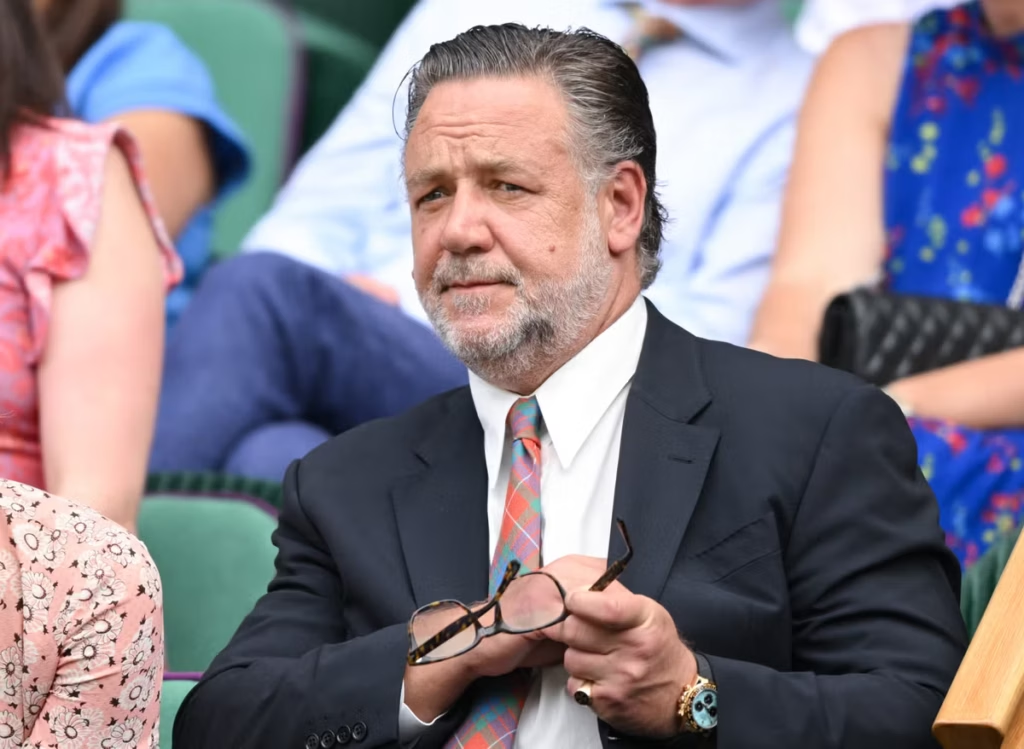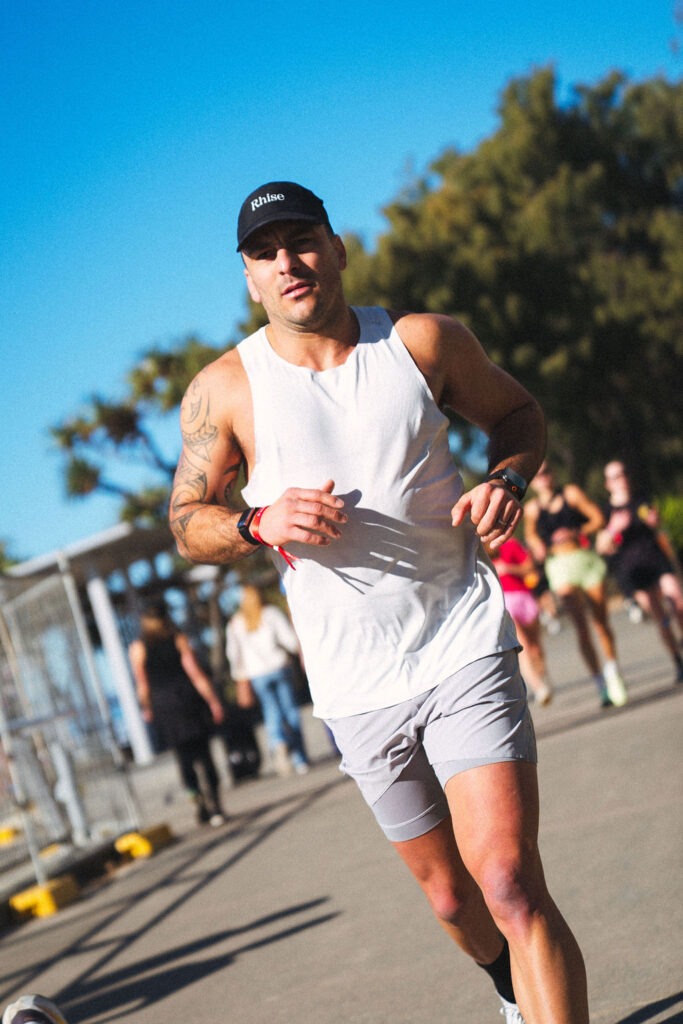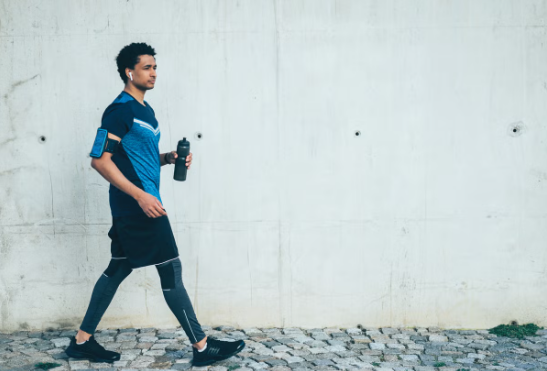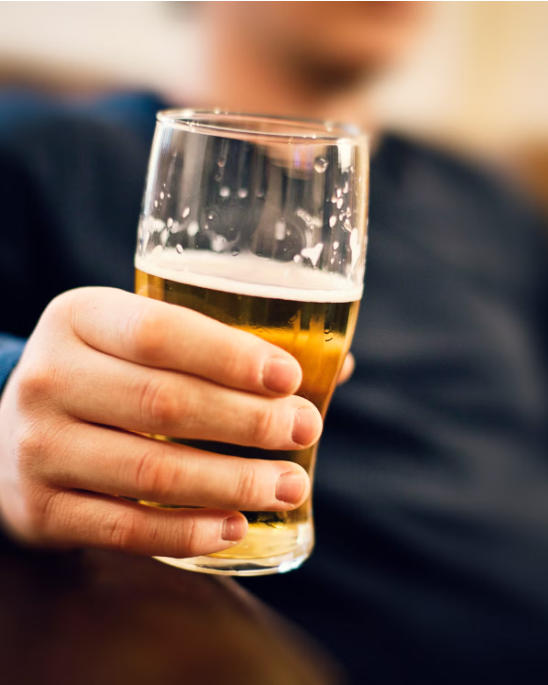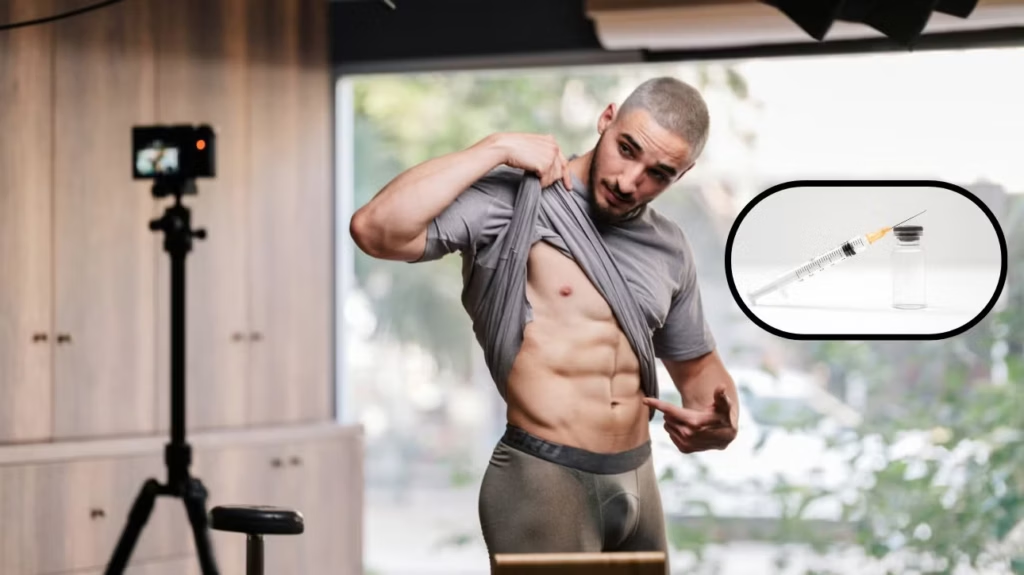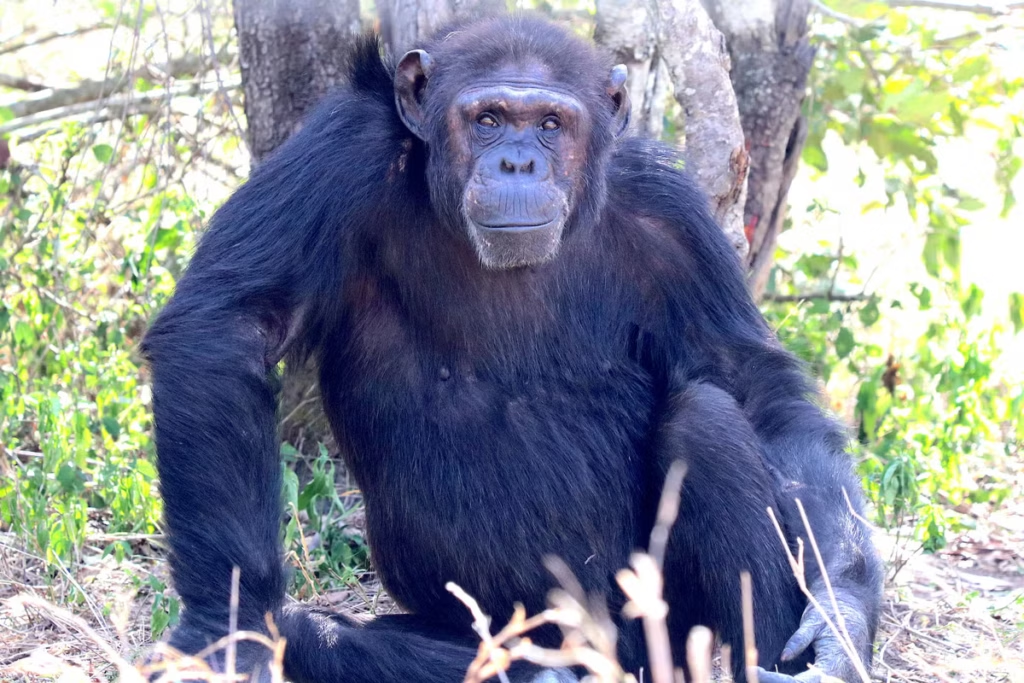IT’S NOT HARD to pick out Tyson Pedro at Ethos Fitness in Sydney’s Silverwater. Inside the simple glass box of a gym tucked away on the ground floor of a nondescript office building on an industrial street, I find him midway through a series of barbell hip-thrusters. To his left, a UFC fight plays on a flatscreen as Snoop’s ‘Who Am I’ pounds away on the stereo.
Rangy yet powerfully built, tattoos fight to catch the eye on Pedro’s upper body—I can make out his beer label logo, Drink West, under his left pec, while his back is dominated by images of a samurai and a demon—representing good and evil, the fighter tells me later. His left shoulder features an image of his cousin, who was killed serving in Afghanistan, while his thighs carry traditional Samoan designs. Only his calves have escaped the needle.
Between exercises Pedro checks in on a screen at the gym’s central pillar before moving on to the next exercise. He’s working in concert with an older, heavier set man with a similar array of ink. That would be John Pedro, Tyson’s father, a man whose reputation is the stuff of MMA legend.
While father and son train side by side, they barely acknowledge each other, both carrying a steely gaze as they knock out their reps. Pedro’s daughter and nephew are mucking around on some padded boxes nearby, while his wife, Rosie, looks on. “It’s the whole Brady Bunch in here today,” Pedro tells me, as we chat afterwards in the gym’s office, a towel draped over his shoulders. He’s right, there is something wholesome about the scene: a family hard at work in the gym, kids playing around them. Very Brady Bunch, very sweet. In some ways it recalls aspects of Pedro’s own childhood. In others, though, it’s markedly different.
Back then, father and son were master and apprentice and rather than side by side, tended to clash head on. “[It was] pretty normal, except we just fought a lot,” says Pedro of a childhood you could describe as both formative and complicated. “Essentially, we’ve always been fighting. I’ve only been knocked out twice, both times by my dad. Dad just thought he was raising Spartans.”
You could argue that’s exactly what John was doing. Afterall, you don’t name your son Tyson for nothing.

Cotton knit tank, POA, and cotton pants, $380, by Venroy.
UNLESS YOU’RE AN MMA lifer, the name John Pedro probably doesn’t mean a lot to you. But MMA in Australia owes a lot to John, who helped pioneer the sport over here as owner and operator of the King of the Cage promotion. A self-described ‘hood rat’, John, who is of American Samoan descent, grew up in LA with a gangland past, running with the notorious Bloods in Oceanside.
The story of how John made it out here to Australia is an interesting one: his own father’s dying wish was that his son serve as a Mormon missionary. “In America, half my family is Mormon, half the family is on the other side of the path,” says Pedro, offering a smile that’s all the more disarming for his tattooed body and cauliflower ears.
John would meet Pedro’s mum, Karran, here in Australia. The pair had three kids; Pedro has a younger brother and a sister, who’s now married to UFC heavyweight Tai Tuivasa. Fighting was in the blood, though John chafed against the media’s perception of MMA as a ‘bloodsport’. He began teaching his son Japanese Jujutsu and Kenpō Karate when he was just four years old. “We’d always be doing weapons and we started the ground game a lot earlier than a lot of other people,” says Pedro.
The young Pedro would also box, but at his mother’s urging he tried his hand at non-combat sports, including football, league, tennis, volleyball and basketball. “My mum wanted me to do everything but fighting,” says Pedro. “She absolutely hates it. Still hasn’t come to any of my fights [in MMA]. Never watched one. Hasn’t watched replays. Nothing.” She did watch him box once at a Blacktown youth club. That was enough. “I got hit, but he [the opponent] stepped on my foot at the same time and I fell down. She screamed so loud that everyone stopped, even the ref. That was it for her.”

Tank, $69, and shorts, $119, by P.E Nation.
Pedro’s parents would split when he was 12. His siblings went to live with their mum. Pedro stayed with John. That meant he kept doing martial arts. It also meant he kept fighting with his old man.
“It’s crazy, now, looking back on it,” says Pedro, shaking his head as he begins to recall a childhood marked by lessons in combat. “He wasn’t ready for kids, like a lot of adults at that age and he just had a different kind of switch. You weren’t allowed to make mistakes, whether it was martial arts or you spilled a drink or anything. He was just very hard and you never knew when that switch was going to get flipped.”
What happened if you made a mistake, I venture. It’s difficult to tell if Pedro is smiling or grimacing when he answers. “You’d get beaten. I try not to get him in trouble, make him look bad. My front teeth are fake. I’ve got a broken nose. I got a lot of hidings, as did a lot of Polynesian kids from that area. I think it was just passed down. They didn’t know any different.”
That shot to the mouth came when Pedro was 16 and told his dad he wanted to fight in the UFC. John told him to put on some gloves and get in the cage. John said he wouldn’t hit him, then Pedro clocked his old man. The switch got flipped. Next thing Pedro knew he was on the canvas with his front teeth missing. But the fight didn’t end there. John made his son keep fighting. Afterwards, he told Pedro how proud of him he was.
There’s another incident that leaps from the pages of Pedro family lore: the stabbing.
“That was more of a game we were playing—he used to throw a knife and try and catch it—and we were just trying to get each other to flinch and it just kept escalating and he missed the catch and it went straight into my chest,” says Pedro, pointing to his sternum. “I actually got in trouble after that for playing the game. He was like, ‘You made me play this fucking game. Don’t tell your mum’.”
To Pedro, the knife wound was just another scar. He begins patting his shoulders, chest, the top of his head. “Man, there were always scars on my head, my body. I didn’t know any different. I just thought that was how you grew up.”
How did he feel about all the hits he was taking, all the fists he was eating, back then? “Man, to be honest, I think I was just trying to maybe people please, because I was always trying to get his love, always trying to just show him that, I’m the son you wanted. He could almost do no wrong in a sense.”
What about now? Do those scars linger? Have he and his old man talked about the way things were back then? “We are starting to talk a lot more,” says Pedro. “He came from an era where you don’t talk about your problems. And it’s cool now that I’ve been training with dad so much. I drive him around and we get a lot of time to talk. He sends me messages just apologising or saying, ‘You’re my eldest son. I wasn’t ready’. And I’m like, Man, dad would never have said this in a million years. How he talks about me now almost brings a tear to my eye. It’s just cool to see him grow as a man. I think becoming a granddad, that changed him.”
Pedro feels that to this day no one has hit him as hard as his dad did. “Maybe that’s a psychological thing because I know some of these guys are definitely hitting harder,” he says. “Maybe they’re not hitting me emotionally as hard.”
And here’s the kicker: “I wouldn’t change anything because it made me who I am.”

Cotton knitted shirt, $269, and linen shorts, $219, by Calibre.
PEDRO IS UNLEASHING a kick towards the heavens, the tranquil waters of picturesque Little Bay, where I catch up with him a few days later for the MH shoot, offering an exquisite frame for an image that underscores both the sublime beauty and ferocious intent possible in martial arts.
There was never any question that Pedro would end up fighting as a career. It was just a matter of which style. It would turn out to be all of them. He would win the NSW state titles in boxing and train for the Olympics, but despite his success, he grew weary of the sweet science. He liked the complexity and range of the grappling styles, the chance to use all his limbs, unleash all his weapons. And he liked that in martial arts, you never stop learning. “Japanese jujutsu has a lot of grappling, but also has the striking,” he says. “And then I went back to Brazilian jiu-jitsu for a little bit and it’s just evolving so fast and I liked that idea of it changing so much. I still love boxing, but when you think about it, the biggest change has been from that to that in the past 100 years,” he says, inverting his fists from palms out to palms in. “So I think it’s just the evolution of MMA that I love. And you never feel like you’ve learnt it all.”
John’s legacy isn’t just a son who’s as hard as a proverbial coffin nail. It’s also one who’s a keen, and shrewd, student of combat sports. “I’ve trained at different gyms around the world and I’ll go, Oh, that works for me or that works for me. I can take a little bit of everything because I’ve never been to one gym, except City Kickboxing [Israel Adesanya’s gym], where I go, Oh yeah, that’s my whole system in one thing.” It’s the same with mentors, he says. “I’ve never seen one person where I go, I only look up to that person. I’m like, Oh, I can take a little bit from you, a little bit from you and try and make it into my own thing.”
Pedro’s entry into the UFC was perhaps ahead of schedule and came about thanks to a combination of chutzpah—after winning the Australian Fighting Championship 17 in October 2016, Pedro called out UFC president Dana White saying, “UFC I’m ready”—and good fortune. “I was literally the only fighter who was available and I’d only had four fights, so probably shouldn’t have got a call up yet,” he says. “But all the stars aligned and they’re like, ‘Do you want to fight in four weeks?’ And I was like, ‘Yeah’. They’re like, ‘Do you want to know who, where?’ I said, ‘No, if it’s the UFC, I’m in’.” It ended up being Khalil Rountree, now ranked number eight in the light heavyweight division, at UFC Fight Night: Whittaker vs. Brunson, in Melbourne.
Pedro would beat Rountree, before going 3-3 in his first six fights in the UFC. In the last of these bouts, against Maurício Rua in 2018, he would injure his knee. He didn’t know it at the time but he wouldn’t fight again for four years. For a man who’d grown up fighting, it would be too long.

Swim shorts, POA, by Tommy Hilfiger.
AS PEDRO PERFORMS a head turning, head flip on the sand at Little Bay, his lithe, supple limbs betray no evidence of the crippling knee injuries that very nearly ended his career.
The first knee reconstruction went well, he says. He worked out at Ethos every day with trainer, Meer Awny. “I was like, Let’s go. I got this. Then the second one I was like, Oh man, this is getting pretty tough. I think we were about two years in at that stage. The third knee injury was the killer. I was like, Fuck this.”
With hope of a return to the Octagon disappearing, Pedro would blow out to 110 kg from his fighting weight of 93 kg. With no fights on the horizon, money started to become an issue. People around him told him to retire. “It was getting to the stage where they’re like, ‘Man, you’ve got to give up your dream’.”
Without a fight to prepare for, life can get complicated for Pedro, whose motto is ‘peace through violence’. “When I’m in the Octagon I just get this tunnel vision and it’s serenity in there,” he says. “You’re not thinking about anything else. No problems, no dramas. It’s very easy. As soon as you come out, there’s always problems.”
Ironically perhaps, the nadir would come when the finish line was in sight. Pedro began drinking just before he was due to go into camp for his return fight. “I was watching Tai’s fight,” he recalls. “That’s where it started. I just started on the beers and just kept drinking.” It would turn into a multi-day bender in which he went missing from his family. The 32-year-old refers to it now as a nervous breakdown. “I signed the contract and I just felt overwhelmed with the idea of coming back for the fight, the reliance on money for the family. Everything had to succeed now because I’d got everyone to believe in me for four years. So, I almost felt like I was just running away from the bigger effort.”
It was John who pulled him out of it. He’d been in New Zealand but flew straight home when Rosie called him. “He picked me up and just said, ‘Let’s go. Let’s get to work’. And I was like, ‘Alright, sweet, let’s go’.”
Pedro’s return to the Octagon at UFC 278 against Harry Hunsucker in August 2022 was as euphoric as it was emphatic. He stopped Hunsucker with a front kick to the body and ground and pound. “That was, again, overwhelming,” he says. “I remember after I won that fight, I was still on and still wanting to fight the ref, fight everyone because there was just so much adrenaline going through me. I remember walking out the back and we sat down for a second and then it just flooded me and I started bawling my eyes out. It was too much for one moment.”

Anorak, $249, by Calvin Klein.
WHILE FIGHTING MIGHT be his life, Pedro knows he can’t do it forever. During his four years out he started a number of side gigs, including Drink West, his beer label with Tuivasa and Penrith Panthers’ skipper Nathan Cleary. He’s been a sought after collaborator for major fashion labels and recently landed a role in a feature film set in the MMA world that’s due to shoot this year. He also hosts The Halfcast Podcast with Tuivasa, will star in Channel 10’s reboot of Gladiators, launching this month and after our chat he has a meeting about setting up a children’s foundation.
If that weren’t enough, there have been offers in the past to turn his and John’s lives into a movie. Pedro also wants to write a book, but at the same time, is conscious of not getting distracted from fighting. Besides, he says, his story isn’t finished, a reason he gives for not yet having gone on The Joe Rogan Experience podcast. “There are a couple of things I want to tick off the list before I go on there.”
Like what? He smiles. “I’d rather just show everyone.”
The ‘show’ will begin with his next fight. Pedro is currently in the process of adding weight ahead of fight camp. He’s at 104 kg, aiming to get to 106 kg, before cutting to 93 kg for a fight, likely to be in the first quarter of this year. Getting to that weight involves a lot of pies and pizzas.
“It’s pretty shitty,” says Pedro. “Last camp my nutritionist was making me eat pizzas and burgers in between my meals because I was just cutting weight too fast. I was dropping three kilos a session and having to eat just to get it back on.” Of course, the boom-bust extremes of preparing for a bout mean that once you do begin your cut, those same pizzas you were almost gagging on a week ago, suddenly loom large in your mind’s eye. “I follow a lot of food pages,” says Pedro, with a chuckle. “When I’m cutting weight, I’m like, I’ll have that one and that one and that one.”
Adesanya’s camp at City Kickboxing in New Zealand is brutal, he says. “Most gyms are like two [workouts] a day max, but they’re doing four or five sessions a day sometimes.” Outside of camp, Pedro does strength and conditioning at Ethos in the mornings and either jujutsu or boxing in the evenings. “That’s my staple. Going back into camp, that’s all I do. It’s not too hard on the body. I try not to do too much wrestling or too much kickboxing.”
Camp is a physical and mental crucible designed to break a fighter down and build him back up again, to push the mind and body to breaking point, to sharpen instincts like a blade on stone and, ultimately, fortify the spirit for battle. By the end Pedro will be ready.
“I feel like I unlocked a new mentality in the last fight [against Anton Turkalj at UFC 293 in Sydney] where I went full monk,” he says of his fight prep. “Normally I take my computer and do a lot of other things while I’m in fight camp. That last one I did nothing. I just sat in my room journalling, meditating. I did everything perfect and it was weird but I got to the last page of my journal and where normally I can see all my goals, I couldn’t see anything past it [the fight] and I felt like I was ready to die in that fight. It gave me this sense of freedom. I was able to just flow. It was the freest I’ve ever felt in there.”
Finding freedom in the cage is the result, he says, of unlocking your alter ego, something Pedro’s been working on with Adesanya’s mental performance coach, David Niethe. “Tyson Pedro has a lot of flaws, a lot of weaknesses,” Pedro says. “Through camp we undergo this transformation so that by the time you enter the cage you’re ready to unleash your alter ego.” An idealised, optimised expression of who you are: your best self.
Who or what is Pedro’s alter ego? A rōnin, he says. I nod. A martial inspiration makes sense for a fighter, though perhaps this one is open to some narrative interpretation. In feudal Japan, a samurai becomes a rōnin after the death of his master, or after the loss of his master’s favour. Pedro, you could argue, did the opposite. He earned his master’s favour. His respect, love and approval, too. Yes, he had to fight tooth (literally) and nail, for them. But he’s his own man and master now.
Tyson Pedro’s MMA gym workout
Pedro uses this workout to build the total-body strength and stamina required to go five rounds in the Octagon. Use it to fortify your physique.
>Hang clean shrug – 4 x 4
>Single-leg dumbbell depth landing – 3×5
>Barbell hip thrust off box – 4 x 8, 8, 6, 6
>KB swing – 3 x 8
>DB wrist extension – 3 x 12-15
>DB Seal Row – 4 x 8
>Cable side bend – 3 x 12
>Half-kneeling cable serratus punch – 3 x 8

Above: Swim shorts, $109, by Calvin Klein. Opening image: Tank, $69, and shorts, $119, by P.E Nation.
Photography: @stevenchee
Styling:@grantpearce.inc
Skin:@moniquejonesmakeup
Social: @ariellekatos
Related:
Uli Latukefu keeps on fighting
Dwayne The Rock Johnson on getting into the best shape of his life at 50








